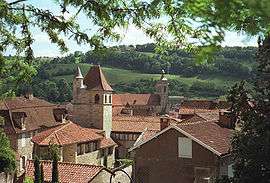Figeac
| Figeac | ||
|---|---|---|
|
A general view of Figeac | ||
| ||
 Figeac | ||
|
Location within Occitanie region  Figeac | ||
| Coordinates: 44°36′31″N 2°01′54″E / 44.6086°N 2.0317°ECoordinates: 44°36′31″N 2°01′54″E / 44.6086°N 2.0317°E | ||
| Country | France | |
| Region | Occitanie | |
| Department | Lot | |
| Arrondissement | Figeac | |
| Canton | Figeac | |
| Intercommunality | Pays de Figeac-Cajarc | |
| Government | ||
| • Mayor (2014–2020) | André Mellinger | |
| Area1 | 35.16 km2 (13.58 sq mi) | |
| Population (2011)2 | 9,773 | |
| • Density | 280/km2 (720/sq mi) | |
| Time zone | CET (UTC+1) | |
| • Summer (DST) | CEST (UTC+2) | |
| INSEE/Postal code | 46102 / 46100 | |
| Elevation |
170–451 m (558–1,480 ft) (avg. 225 m or 738 ft) | |
|
1 French Land Register data, which excludes lakes, ponds, glaciers > 1 km² (0.386 sq mi or 247 acres) and river estuaries. 2 Population without double counting: residents of multiple communes (e.g., students and military personnel) only counted once. | ||
Figeac (French pronunciation: [fiʒak]; Occitan: Fijac) is a commune in the Lot department in south-western France. Figeac is a sub-prefecture of the department.
History
Figeac is on the via Podiensis, a major hiking medieval pilgrimage trail which is part of the Way of St. James. Today, as a part of France's system of trails it is labelled the GR 65.
Notable people
Jean-François Champollion, the first translator of Egyptian hieroglyphics, was born in Figeac, where there is a Champollion Museum. On the "Place des écritures" (writings place) is a giant copy of the Rosetta stone, by Joseph Kosuth.
The actor Charles Boyer was also born in Figeac.
Media
Louis Malle's 1974 film, Lacombe Lucien, was filmed in Figeac.
See also
External links
| Wikimedia Commons has media related to Figeac. |
![]() Chisholm, Hugh, ed. (1911). "Figeac". Encyclopædia Britannica (11th ed.). Cambridge University Press.
Chisholm, Hugh, ed. (1911). "Figeac". Encyclopædia Britannica (11th ed.). Cambridge University Press.

